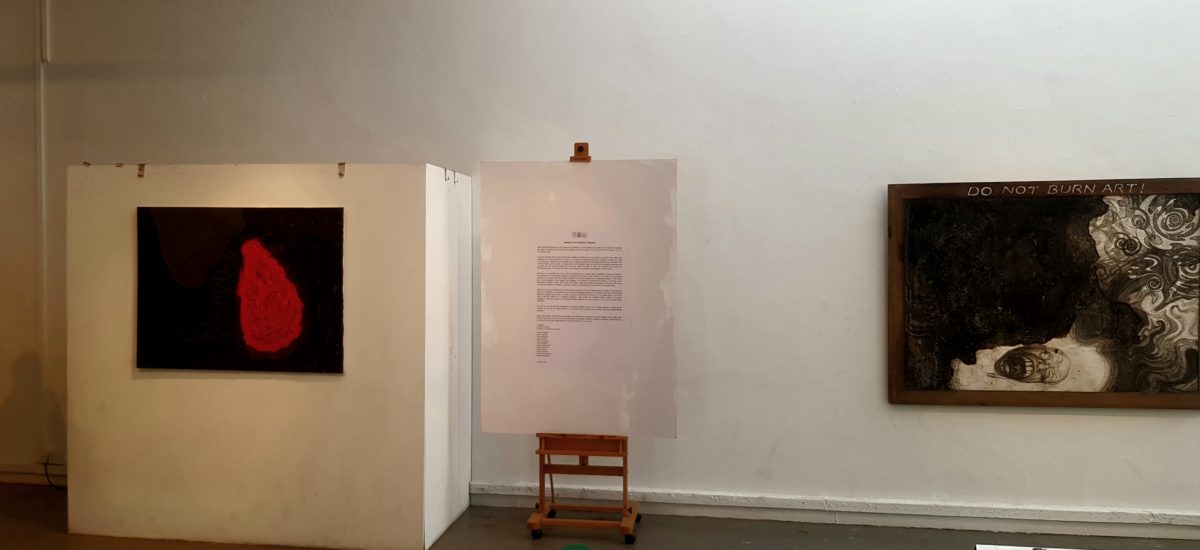When the GotaGoGama Protest site was attacked by supporters of Mahinda Rajapaksa on May 9, a row of tents were destroyed and burned to the ground by the rowdy gang that descended on the peaceful protest site that day. One of the tents caught in the destruction was a gallery and studio set up by Visual Artist Sujith Rathnayake. The tent had been set up to encourage and elicit conversation around the site through the painting, drawing and displaying of mixed media artworks. It aimed to provoke questions on economic decline, police brutality, the people’s power and in essence record everything the Galle Face aragalaya stood for and stood against.
Yet even as May 9 did not bring the end of the Aragalaya, it neither marked the end of Sujith’s stay at the protest site. The studio was rebuilt and the gallery continued to be a seminal part of the Argalaya’s protest space at Galle Face that brought many conversations to the forefront, and asked the public on what and how they engaged with them. However, after the ousting of Gotabaya Rajapaksa, the dimensions of the struggle changed. By mid July as the people had occupied the Presidential Secretariat and the Prime Minister’s office, a political deadlock was broken, and out of it Prime Minister Ranil Wickremesinghe emerged as the country’s politically appointed president, within this development emerged a new wave of repression and arrests by a reinvigorated police armed with a new sense of purpose in brutality. It was this climate which defined the opening days of the Wickremesinghe presidency.
Slowly but surely the Aragalya as a geographical entity withered away. Galle Face was no more a space for the people.
It is within this landscape in the aftermath of a successful people’s protest movement and the emergence of government without a people’s mandate that the broad strokes of Rathnayake’s art changed once more, transitioning from an unconventional outdoor space to an established enclosed gallery space. Sujith Rathnayake no longer wished to carry on his protest on the street in a space of police repression. And through a fusion of introspection and collaboration he began working on a new series of visual and mixed media art to capture the present mood of the nation and public during the interim months. Still his own form of expression stemmed from the spirit of the protests site he had been involved in. The product of this process and transition is what was exhibited at the Lionel Wendt art gallery over this past week. Titled Arbudhaya saha Aragalaya (Crisis and Struggle) Rathnayake has aptly termed his art a visual art attack for its provocative work of twisted figures, rusted metal and bloodshot landscapes.
“What I am trying to do is take the struggle forward by exploring the existing mood of the public and their consciousness to what is happening within the current context,” says Rathnayake. The 11 artworks displayed in the exhibition convey how the atmosphere of repression has come to define the public mood. A clash between the progressive minded youth who came together to challenge a corrupt political culture and the old order that hung on long enough to re-assert itself when it was on the brink of collapse.
Although the installation is in extension of the ideals of the Aragalaya, Rathnayake is adamant that it is not some sort of blind idealistic connection. “This isn’t a showcase of propaganda.” It sticks true to the observatory and artistic principles that are at the core of his discipline. As much as stark and provoking contrasts of colour play a big role in the immediate visual understanding of Rathnayake’s work, it is their texture and character that draw out a response. The dark red of blood swirling around within the rusted metallic tinges of bronze and grey. The five pieces titled Rusted Acts, for example, observe the use of the Prevention of Terrorism Act (PTA) against the public protesting the economic decline of Sri Lanka. The recurrence of rust as a major component highly symbolic here, as it points to the outdated and archaic nature of the PTA that has been in use since 1979. It is a piece of legislation that has no use in a modern republic. The use of such an act on peaceful demonstrators is an act of utter evil, Rathnayake claims.
“I was trying to invoke how this act is an infringement on our own humanity. That is the reason I juxtapose the red of our blood against the textures of corroded metal. I contrast them to find some sort balance between these two.”
Speaking on what the future of the Aragalaya and the country at large is Rathnayake is less than optimistic. If the people elect corrupt leaders, it means that the people are corrupt too. This has been the case with Sri Lanka for most of the years since Independence. Sri Lanka is a country that cannot be fixed in a short time but an important step was made in 2022, it is our duty to carry the struggle forward, he said.


